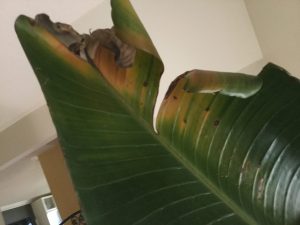
Hello we are following up with you about our bird of paradise that got burnt in the summer. Please see attached the leaf with almost a rust lik aspect, some black marking on the stem and a bend on the stem. If you expand the pictures you see a bit better. I wanted to send you a picture of each part I am discussing, however your site only allows 1 photo. I tried the video and it said invalid. We are not sure if we should just totally cut it back or discard it. Our other bird of paradise leaf, the last photo, the edges are getting quite brown. I don’t know if this is due to the heat in the house? We have recently plugged in a humidifier for this area. Any help is most appreciated. Thank-you
Strelitzia (bird of paradise), like most indoor houseplants, often has leaves that turn brown at the tips, due to drying out. The top of your photo shows dried portions of a leaf, while lower down the leaf we can see yellowed areas with black spots.
If the soil has been too wet or the plant has been over-watered, one concern might be a fungal disease called root rot – symptoms would include discolouration of leaves and death of branches, and with one type of root rot (armillaria) there would be clumps of mushrooms at the base of the plant. Bacterial wilt can also attack birds of paradise – this is a bacterium carried in the soil that initially causes leaves to wilt and yellow and the base of the plant would turn brown or black at the soil line. As you mention only the leaf, and not any other part of the plant being affected, I don’t believe that either of these are the culprit.
Leaf spot, which can be caused by a bacteria or fungus, can also affect the leaves – and might be responsible for the black spots in your photo. Common causes are excessive moisture or poor air circulation. Remove infected leaves and any infected leaf bits that have fallen onto the soil and be sure not to get water on the leaves. Water early in the day so that the surfaces of the leaves have time to dry relatively quickly. Birds of paradise tolerate dryness and mature plants may only need to be watered around once a week – allow the top 5 cm (2 inches) of soil to dry before watering. Make sure there is plenty of space around the plant so it gets good air circulation. The plant should also be in a pot that has a drainage hole, so excess water can flow out – it does not like wet feet. The humidifier may make the discolourations/spots worse, if excessive moisture/humidity is the culprit. I’d suggest that you turn off the humidifier for a few weeks and watch to see how the plant responds. If the symptoms resolve, keep the humidifier off, if the leaves dry and curl, turn it on again. It should also be placed in an area of the house where it gets lots of bright, indirect light.
You will see that only one photo reached us. Unfortunately, we cannot “expand” the photos that are uploaded to our site – the resolution is not great, they just become fuzzy. If you have additional photos/videos, you might want to take these to your closest nursery to see if experts there can help identify what is going on with your lovely plant. Details including how the plant was “burnt” (from excessive fertilizer? sun scorched if you over-summered it outdoors or if it received bright direct sun indoors during the summer?) and whether only the leaf is affected (not other parts of the plant), would be helpful. As well, the nursery folks would likely want to know when the symptoms started, how these have progressed and what you have done to try and nurse the plant back to health.
All the best with your bird of paradise!

